INTRODUCTION
Polycystine radiolarians are
exclusively marine, pelagic, solitary or colonial protists
provided with actinopods. Polycystines comprise the Collodaria, a
small group lacking a skeleton, or provided only with scattered
mono- or polyaxonic spicules; and the Spumellaria and
Nassellaria, most of which have a well developed siliceous
latticed or spongy skeleton (see "Sedimentary vs.
water-column materials.").
Solitary species (the greatest majority) range between 20-30 µm
to about 300 µm, but colonies (some Collodaria and the
spumellarian family Collosphaeridae) may in exceptional cases be
as long as 3 m (Swanberg 1979). The siliceous skeletons of the
polycystines are a major contributor to the sedimentary flux,
their earliest records dating back to the Cambrian. Paleozoic,
Mesozoic and Cenozoic sequences furnish detailed records for
evolutionary, stratigraphic and paleoecologic analyses.
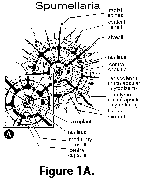 A distinguishing feature of all radiolarians
(polycystines and phaeodarians) is the central capsule, a
proteinaceous perforated membrane that divides the cytoplasm into
two areas: the endoplasm or intracapsular cytoplasm, and the
calymma or extracapsular cytoplasm (Figure 1A).
A distinguishing feature of all radiolarians
(polycystines and phaeodarians) is the central capsule, a
proteinaceous perforated membrane that divides the cytoplasm into
two areas: the endoplasm or intracapsular cytoplasm, and the
calymma or extracapsular cytoplasm (Figure 1A). 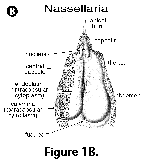 This central capsule is either spherical (in
many Spumellaria), or elongated and pyriform (in most
Nassellaria, Figure 1B). The intracapsular cytoplasm contains
reserve substances and major cytoplasmic organelles (nucleus or
nuclei, mitochondria, and other organelles, except for the
digestive vacuoles), and is generally believed to be responsible
for the functions of reproduction, biochemical synthesis and
energy production. The calymma is the frothy or web-like
extracapsular cytoplasm where the digestive vacuoles are located.
Algal symbionts, when present, are enclosed within vacuoles
usually located in the calymma. Colonial forms have a gelatinous
sheath containing numerous central capsules interconnected by a
rhizopodial network.
This central capsule is either spherical (in
many Spumellaria), or elongated and pyriform (in most
Nassellaria, Figure 1B). The intracapsular cytoplasm contains
reserve substances and major cytoplasmic organelles (nucleus or
nuclei, mitochondria, and other organelles, except for the
digestive vacuoles), and is generally believed to be responsible
for the functions of reproduction, biochemical synthesis and
energy production. The calymma is the frothy or web-like
extracapsular cytoplasm where the digestive vacuoles are located.
Algal symbionts, when present, are enclosed within vacuoles
usually located in the calymma. Colonial forms have a gelatinous
sheath containing numerous central capsules interconnected by a
rhizopodial network.
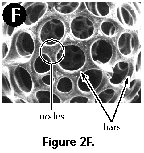 Polycystine skeletons are typically
constructed of a network of structures which can be either
connected at both ends with other elements - the bars (Figure
2F), or formations attached
to the rest of the shell by one end only - the spines (Figure
2A-B, 2G). All skeletal elements are composed of
amorphous silica (SiO2 nH2O). There is
a perplexing variety of shapes in which these bars and spines can
be arranged in order to form the skeleton, from simple latticed
spheres or a few anastomosed spines (Figure 15.119), to elaborate
constructions with several concentric spheres (Figure 2B) or
multilocular conical structures with protruding latticed or solid
appendages known as wings, feet, teeth, etc. (Figure
3O-P, and 3Q-R).
Polycystine skeletons are typically
constructed of a network of structures which can be either
connected at both ends with other elements - the bars (Figure
2F), or formations attached
to the rest of the shell by one end only - the spines (Figure
2A-B, 2G). All skeletal elements are composed of
amorphous silica (SiO2 nH2O). There is
a perplexing variety of shapes in which these bars and spines can
be arranged in order to form the skeleton, from simple latticed
spheres or a few anastomosed spines (Figure 15.119), to elaborate
constructions with several concentric spheres (Figure 2B) or
multilocular conical structures with protruding latticed or solid
appendages known as wings, feet, teeth, etc. (Figure
3O-P, and 3Q-R).
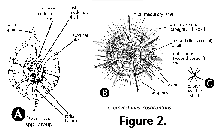 Very
little is known about the reproduction of the Radiolaria. In
addition to vegetative reproduction (Hollande and Enjumet 1953), the production of biflagellated swarmers
was observed, but it is not known if the swarmers are asexual
dissemules or motile gametes (Anderson 1983a). Although no direct estimates have been
made so far, it is generally assumed that individual radiolarian
life spans are around two to four weeks (Anderson 1983a; Caron and Swanberg 1990).
Very
little is known about the reproduction of the Radiolaria. In
addition to vegetative reproduction (Hollande and Enjumet 1953), the production of biflagellated swarmers
was observed, but it is not known if the swarmers are asexual
dissemules or motile gametes (Anderson 1983a). Although no direct estimates have been
made so far, it is generally assumed that individual radiolarian
life spans are around two to four weeks (Anderson 1983a; Caron and Swanberg 1990).
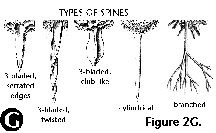 Polycystines consume a wide variety of prey
including bacteria, algae, protists, copepods, appendicularians,
and other small zooplankton (Anderson 1983a, 1993; Caron and Swanberg 1990). Algal symbionts, when present, secrete
photosynthetic products that are assimilated by the host as a
nutritional source (Anderson 1983b).
Polycystines consume a wide variety of prey
including bacteria, algae, protists, copepods, appendicularians,
and other small zooplankton (Anderson 1983a, 1993; Caron and Swanberg 1990). Algal symbionts, when present, secrete
photosynthetic products that are assimilated by the host as a
nutritional source (Anderson 1983b).
The first published descriptions of
Radiolaria date back to the early nineteenth century. Between
approximately 1850 and 1900, C. G. Ehrenberg, J. Müller, R.
Hertwig, A. Popofsky, and especially E. Haeckel described
thousands of new species and provided the first comprehensive
classification systems (Riedel 1967a). After a period of little activity,
interest in the Radiolaria was renewed around 1950, and somewhat
later further fostered by the rich sedimentary materials
recovered by the Deep Sea Drilling Project.
 Because of their application to
stratigraphy, polycystine studies have traditionally been within
the realm of geologists/paleontologists, with
biologically-oriented publications representing less than 10% of
the overall total produced to date (A. Sanfilippo, personal
commun., 1997). The directory included in the 1994 issue of
Radiolaria (Newsletter for the International Association of
Radiolarian Paleontologists) lists 400-plus names; however, only
100-150 of these are primarily concerned with radiolarian
studies.
Because of their application to
stratigraphy, polycystine studies have traditionally been within
the realm of geologists/paleontologists, with
biologically-oriented publications representing less than 10% of
the overall total produced to date (A. Sanfilippo, personal
commun., 1997). The directory included in the 1994 issue of
Radiolaria (Newsletter for the International Association of
Radiolarian Paleontologists) lists 400-plus names; however, only
100-150 of these are primarily concerned with radiolarian
studies. 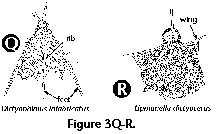 Almost all these workers are geologists
focusing their interest on stratigraphic and paleoceanographic
problems, especially dealing with Paleozoic and Mesozoic
deposits; interest in Cenozoic faunas has been dwindling over the
last few years. Biologically-oriented research based on samples
from the water-column has even fewer specialists, and at present
they are probably less than 10-20 world-wide. Since 1834
approximately 3500 works on polycystine radiolarians have been
published (over half of these on Cenozoic faunas, about 35% on
Mesozoic, and 15% on Paleozoic; A. Sanfilippo, personal commun.,
1997).
Almost all these workers are geologists
focusing their interest on stratigraphic and paleoceanographic
problems, especially dealing with Paleozoic and Mesozoic
deposits; interest in Cenozoic faunas has been dwindling over the
last few years. Biologically-oriented research based on samples
from the water-column has even fewer specialists, and at present
they are probably less than 10-20 world-wide. Since 1834
approximately 3500 works on polycystine radiolarians have been
published (over half of these on Cenozoic faunas, about 35% on
Mesozoic, and 15% on Paleozoic; A. Sanfilippo, personal commun.,
1997).
 A distinguishing feature of all radiolarians
(polycystines and phaeodarians) is the central capsule, a
proteinaceous perforated membrane that divides the cytoplasm into
two areas: the endoplasm or intracapsular cytoplasm, and the
calymma or extracapsular cytoplasm (Figure 1A).
A distinguishing feature of all radiolarians
(polycystines and phaeodarians) is the central capsule, a
proteinaceous perforated membrane that divides the cytoplasm into
two areas: the endoplasm or intracapsular cytoplasm, and the
calymma or extracapsular cytoplasm (Figure 1A).  This central capsule is either spherical (in
many Spumellaria), or elongated and pyriform (in most
Nassellaria, Figure 1B). The intracapsular cytoplasm contains
reserve substances and major cytoplasmic organelles (nucleus or
nuclei, mitochondria, and other organelles, except for the
digestive vacuoles), and is generally believed to be responsible
for the functions of reproduction, biochemical synthesis and
energy production. The calymma is the frothy or web-like
extracapsular cytoplasm where the digestive vacuoles are located.
Algal symbionts, when present, are enclosed within vacuoles
usually located in the calymma. Colonial forms have a gelatinous
sheath containing numerous central capsules interconnected by a
rhizopodial network.
This central capsule is either spherical (in
many Spumellaria), or elongated and pyriform (in most
Nassellaria, Figure 1B). The intracapsular cytoplasm contains
reserve substances and major cytoplasmic organelles (nucleus or
nuclei, mitochondria, and other organelles, except for the
digestive vacuoles), and is generally believed to be responsible
for the functions of reproduction, biochemical synthesis and
energy production. The calymma is the frothy or web-like
extracapsular cytoplasm where the digestive vacuoles are located.
Algal symbionts, when present, are enclosed within vacuoles
usually located in the calymma. Colonial forms have a gelatinous
sheath containing numerous central capsules interconnected by a
rhizopodial network. Polycystine skeletons are typically
constructed of a network of structures which can be either
connected at both ends with other elements - the bars (
Polycystine skeletons are typically
constructed of a network of structures which can be either
connected at both ends with other elements - the bars ( Very
little is known about the reproduction of the Radiolaria. In
addition to vegetative reproduction (
Very
little is known about the reproduction of the Radiolaria. In
addition to vegetative reproduction ( Polycystines consume a wide variety of prey
including bacteria, algae, protists, copepods, appendicularians,
and other small zooplankton (
Polycystines consume a wide variety of prey
including bacteria, algae, protists, copepods, appendicularians,
and other small zooplankton ( Because of their application to
stratigraphy, polycystine studies have traditionally been within
the realm of geologists/paleontologists, with
biologically-oriented publications representing less than 10% of
the overall total produced to date (A. Sanfilippo, personal
commun., 1997). The directory included in the 1994 issue of
Radiolaria (Newsletter for the International Association of
Radiolarian Paleontologists) lists 400-plus names; however, only
100-150 of these are primarily concerned with radiolarian
studies.
Because of their application to
stratigraphy, polycystine studies have traditionally been within
the realm of geologists/paleontologists, with
biologically-oriented publications representing less than 10% of
the overall total produced to date (A. Sanfilippo, personal
commun., 1997). The directory included in the 1994 issue of
Radiolaria (Newsletter for the International Association of
Radiolarian Paleontologists) lists 400-plus names; however, only
100-150 of these are primarily concerned with radiolarian
studies.  Almost all these workers are geologists
focusing their interest on stratigraphic and paleoceanographic
problems, especially dealing with Paleozoic and Mesozoic
deposits; interest in Cenozoic faunas has been dwindling over the
last few years. Biologically-oriented research based on samples
from the water-column has even fewer specialists, and at present
they are probably less than 10-20 world-wide. Since 1834
approximately 3500 works on polycystine radiolarians have been
published (over half of these on Cenozoic faunas, about 35% on
Mesozoic, and 15% on Paleozoic; A. Sanfilippo, personal commun.,
1997).
Almost all these workers are geologists
focusing their interest on stratigraphic and paleoceanographic
problems, especially dealing with Paleozoic and Mesozoic
deposits; interest in Cenozoic faunas has been dwindling over the
last few years. Biologically-oriented research based on samples
from the water-column has even fewer specialists, and at present
they are probably less than 10-20 world-wide. Since 1834
approximately 3500 works on polycystine radiolarians have been
published (over half of these on Cenozoic faunas, about 35% on
Mesozoic, and 15% on Paleozoic; A. Sanfilippo, personal commun.,
1997).